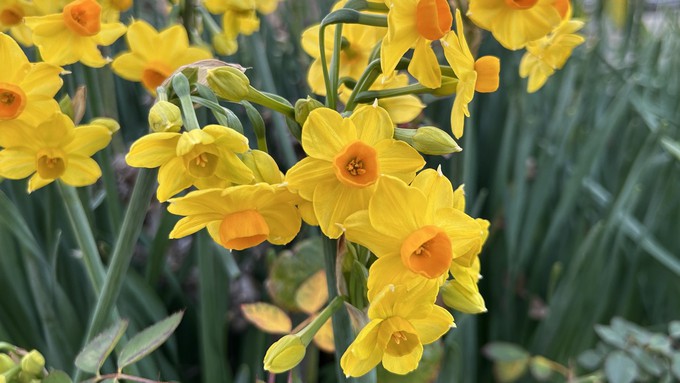
Get comfy indoors during very rainy days to come

This bunch of narcissus may have bloomed extra early, but the flowers' bright color is welcome on gloomy January days. Cut some blooms to bring indoors. Kathy Morrison
Settle in for some wet weather. According to the National Weather Service, Sacramento and the rest of Northern California can expect rain every day between now and Wednesday.
With the brunt hitting late Sunday, the forecast through midweek bounces between “likely rain showers” and “definite rain showers and thunderstorms” before these storm systems finally clear out Thursday. The chance of rain on Sunday and Monday: 95%.
Total precipitation from these twin atmospheric rivers will be somewhere between 1.5 and 3 inches, says the weather service, with communities closer to the foothills expected to get the most rain.
That’s led to a flood watch advisory to be issued by the weather service shortly after noon Saturday for Central Sacramento Valley, Southern Sacramento Valley and the Motherlode. That watch is in effect until at least Saturday night.
These are warm storms with snow only in the higher elevations. Daytime temperatures will hover in the high 50s to low 60s and overnight lows dipping to only the low 50s.
Accompanying all this rain will be some gusty winds – and that can be dangerous. Soggy ground – especially around large trees with roots weakened by years of drought – can give way. If you see a tree leaning or ruptures from roots in lawn around a tree, call an arborist immediately.
Meanwhile, make yourself cozy inside – and wait until your garden has a chance to dry out a little.
* Browse through seed catalogs and websites, and start making plans for spring and summer.
* When forced bulbs sprout, move them to a cool, bright window. Give them a quarter turn each day so the stems will grow straight.
* Give your houseplants some TLC. Dust foliage. Cut off dead or browned leaves.
* Daffodils or narcissus blooming early? Cut some blooms to bring inside and brighten your indoor space.
* Plant bare-root roses, trees and shrubs in large black plastic pots instead of soggy soil. The black plastic will warm up faster than the ground soil and give roots a healthy start. Then, transplant the new addition (rootball and all) into the ground in late March or April as the weather warms.
* Once it stops raining, be careful walking on soggy soil; it can compact easily. Put off transplanting or seed planting at least a week.
* Postpone application of horticultural sprays (such as copper spray for peaches) until at least 48 hours after rain and when rain is no longer in the forecast. These sprays need at least 24 hours to dry.
* Sharpen your tools, especially your pruning equipment.
* After the storms, concentrate on finishing pruning. That includes roses and most deciduous trees and shrubs. The exceptions are spring-flowering shrubs such as lilacs.
* Clean up leaves and debris around your newly pruned roses and shrubs. Put down fresh mulch or bark to keep roots cozy.
Comments
0 comments have been posted.Sacramento Digs Gardening to your inbox.
Sites We Like
Garden Checklist for week of July 21
Your garden needs you!
* Keep your vegetable garden watered, mulched and weeded. Water before 8 a.m. to reduce the chance of fungal infection and to conserve moisture.
* Feed vegetable plants bone meal, rock phosphate or other fertilizers high in phosphate to stimulate more blooms and fruiting. (But wait until daily high temperatures drop out of the 100s.)
* Don’t let tomatoes wilt or dry out completely. Give tomatoes a deep watering two to three times a week.
* Harvest vegetables promptly to encourage plants to produce more. Squash especially tends to grow rapidly in hot weather. Keep an eye on zucchini.
* Pinch back chrysanthemums for bushy plants and more flowers in September.
* Remove spent flowers from roses, daylilies and other bloomers as they finish flowering.
* Pinch off blooms from basil so the plant will grow more leaves.
* Cut back lavender after flowering to promote a second bloom.
* It's not too late to add a splash of color. Plant petunias, snapdragons, zinnias and marigolds.
* From seed, plant corn, pumpkins, radishes, winter squash and sunflowers.